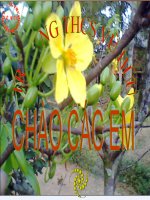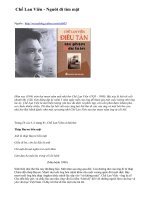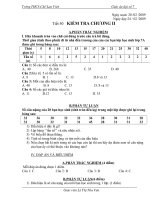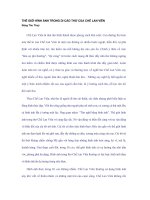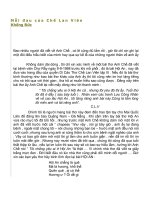peripod 5th che lan vien lower secondary school period 60 p day 250108 t day 280108 unit 10 lesson 1 recycling getting started listen and read 1 2 a objectives i knowledge helps ss to deal wi
Bạn đang xem bản rút gọn của tài liệu. Xem và tải ngay bản đầy đủ của tài liệu tại đây (192.32 KB, 12 trang )
<span class='text_page_counter'>(1)</span><div class='page_container' data-page=1>
<b>*Period: 60</b>
<b>P.day:25/01/</b>
<b>08</b>
<b>T.day:28/01/</b>
<b>08</b>
<b>Unit: </b>
<b>10</b>
<b>Lesson: </b>
<b>1</b>
<b>RECYCLING.</b>
<b>GETTING STARTED & LISTEN AND READ 1-2.</b>
<i><b>A.</b></i><b>OBJECTIVES :</b>
<b>I/ Knowledge : Helps Ss to deal with information about the environment</b>
problems. By the end of the lesson, Ss will be able to do something to
protect the environment & save natural resources.
<b>II/ Skills : Listening and reading</b>
<b>B. TEACHING PROCEDURE :</b>
<b>I/ Greeting and checking absence:(1M)</b>
<b>- Greeting in English:</b>
<b>- Attendance: 8C: 8D: 8E:</b>
<b>II/ Warm - up ( 5M ) : Jumble words.</b>
<b>III/ New lesson :</b>
<b>TEACHER’S ACTIVITIES</b> <b>STUDENTS' ACTIVITIES</b>
<b>PRE-READING</b>
<i>- Introduces the topic & asks Ss to think of</i>
<i>ways to reduce the amount of garbage they</i>
<i>produce.</i>
- Asks Ss to give their opinions base on
the cue given in the getting started
part.
- Comments S’s information.
- Introduces the words by explaining
the meaning, using the situation &
gives example.
- Reads the words for the modal (3
times ). Then helps Ss to repeat ( 2
times ).
- Checks S’s reading in individual &
corrects the mistakes.
- Writes the words on the Bb & checks
the meaning & the pronunciation.
- Corrects & asks Ss to copy the words.
- Introduces the statements & asks Ss
to work in
pairs to predict if the statements are
true or false.
<b>Time: 15 M .</b>
<b>1. Brainstorm:</b>
<i>- Thinking of ways to reduce the</i>
<i>amount of garbage they produce.</i>
<b>-</b> Giving their opinions base on the
cue given in the getting started part.
<b> </b><i><b>Reuse plastic </b></i>
<i><b> bag</b></i>
<b>2. Vocabulary: ROR.</b>
<i><b>- natural resources (n); </b></i>
<i><b> - representative (a); (to)</b></i>
<i><b>protect;</b></i><b> </b><i><b> </b></i>
<i><b> - (to) recycle ; (to)</b></i>
<i><b>contact; </b></i>
- Repeating the words in chorus
& in individual & Correcting the
mistakes
- Giving the meaning & the
pronunciation.
- Copying the words.
<b>3. True - False prediction.</b>
<b>- Working in pairs to predict if the</b>
TIMVIC HEAVOER
VAELETE
CHAWHELERI
CHESTRERT
</div>
<span class='text_page_counter'>(2)</span><div class='page_container' data-page=2>
- Asks Ss to give their predictions &
comments.
<b> * Statements:</b>
<i><b>a. Friends of the Earth is an</b></i>
<i><b>organization to help people make</b></i>
<i><b>friends with each other.</b></i>
<i><b>b. Miss. Blake asks the Ss to</b></i>
<i><b>remember 3 things: reduce; reuse;</b></i>
<i><b>recycle..</b></i>
<i><b>c. Reduce means buying the</b></i>
<i><b>products which are over packed.</b></i>
<i><b>d. We can’t reuse things like</b></i>
<i><b>envelopes, glass, plastic bottles,..</b></i>
<i><b>e. Miss. Blake says that we should</b></i>
<i><b>use cloth bags & shouldn’t use</b></i>
<i><b>plastic bas at all.</b></i>
statements are true or false.
- Giving their predictions.
<i><b>f. Recycling means not just</b></i>
<i><b>throwing things away but</b></i>
<i><b>trying & finding another use</b></i>
<i><b>for them.</b></i>
<b>* Answer keys:</b>
<b>1.F;</b><i><b>to help people protect the</b></i>
<i><b>environment & save natural</b></i>
<i><b>resources</b></i>
<b>2. T; </b>
<b>3. F- </b><i><b>Reduce means not</b></i>
<i><b>buying</b></i><b>; </b>
<b>4. F-</b><i><b> We can reuse things</b></i><b>; </b>
<b>5. T; </b>
<b>6. T.</b>
<b>WHILE-READING</b>
- Helps Ss to listen to the dialogue & Asks
them to check their prediction.
- Asks Ss to give feedback & comments.<b> </b>
- Gives the questions & asks Ss to work
in pairs to asks & answer.
- Asks Ss to give the answer keys by
asking & answering in pairs.
- Corrects S’s answers & comments.
<b>* Questions:</b>
<i><b>1. What does Miss. Blake mean by</b></i>
<i><b>reduce ?</b></i>
<i><b>2. What things can we reuse ?</b></i>
<i><b>3. What does recycle mean ?</b></i>
<i><b>4. Where can we look for</b></i>
<i><b>information on recycle things ?</b></i>
<i><b>5. Why does Miss. Blake tell Lan</b></i>
<i><b>that we shouldn’t use plastic</b></i>
<i><b>bags at all ?</b></i>
<b>Time: 10 M.</b>
<b>4. Presentation dialogue:</b>
- Listening to the dialogue again &
checking their prediction.
- Giving feedback & commenting.
<b>5. Comprehension questions:</b>
- Working in pairs to asks &
answer.
- Giving the answer keys by
asking & answering in pairs.
- Correcting the answers.
<b>* Answers:</b>
<i><b>1. Reduce means not buying</b></i>
<i><b>the products which are over</b></i>
<i><b>packed..</b></i>
<i><b>2. We can reuse things like</b></i>
<i><b>envelopes, glass, plastic</b></i>
<i><b>bottles,..</b></i>
<i><b>3. Recycle means not just</b></i>
<i><b>throwing things away but</b></i>
<i><b>trying & finding another use</b></i>
<i><b>for them.</b></i>
<i><b>4. By having a contact with a</b></i>
<i><b>organization like Friends of</b></i>
<i><b>the Earth.</b></i>
</div>
<span class='text_page_counter'>(3)</span><div class='page_container' data-page=3>
<b>POST-READING</b>
- Introduces the topic “How to protect our
environment” & asks Ss to work in groups of
four to discuss.
- Asks Ss to give their opinion.
- Comments S’s idea.
<b>Time: 10 M.</b>
<b>6. Discussion:</b>
- Working in groups of four to discuss.
- Giving their opinion.
<b>IV. CONSOLIDATION ( Time: 2M):</b>
- Asks Ss to summarize the general idea of the dialogue.
V. HOME WORK: (2M)
- Study the dialogue & the vocabularies & Write the question & full answer
in your notebook.
<b>-</b> Prepare the picture on page 91.
<b>C. SUPPLEMENT:</b>
...
...
...
...
---the
<b>end---*Period: 61</b>
<b>P.day:27/01/0</b>
<b>8</b>
<b>T.day:30/01/0</b>
<b>8</b>
<b>Unit: </b>
<b>10</b>
<b>Lesson:</b>
<b>2</b>
<b>RECYCLING</b>
<b>.</b>
</div>
<span class='text_page_counter'>(4)</span><div class='page_container' data-page=4>
<b>A.OBJECTIVES :</b> To help Ss practice in giving and responding to intructions
and listening for specific information about making compost.
<b>I/ Knowledge : Ss can give and respond to instructions.</b>
<b>II/ Skills: Speaking and listening</b>
<i><b>B.</b></i><b>TEACHING PROCEDURE:</b>
<b>I. Greeting & checking absence ( 1 M ):</b>
- Greeting in English.
<b>- Attendance: 8C: 8D: </b>
<b>8E:</b>
<b>II/ Warm - up ( 5 M ) : Memory game (kim’sgame)</b>
<b>-</b> Look at the picture to the Ss and ask them to observe it carefully, let
them look at the picture for about 20” then put it away.
<b>-</b> Ask Ss write as many words showing things in the picture as possible.
<b>-</b> Possible answer:
Used paper, old newspapers, books, cardboard boxes, bottles, glasses,
jars, plastic bags, food cans, drinking tins, vegetable matter, clothes,
shoes, schoolbags...
<b>III/ New lesson</b>
<b>TEACHER’S ACTIVITIES</b> <b>STUDENTS' ACTIVITIES</b>
<b>PRE-SPEAKING</b>
-Farmer often uses this thing to make
their plants or trees grow well. What’s
it?
-What do you call the fertilizer made
from spoiled food, leaves, and
vegetable matter..
-What are these clothes made of?
<b>-</b> Our shoes, sandals are often made
of...?
<b>-</b> Tell Ss they are going to listen to
the words for items and put them
into right groups.
<b>-</b> Modals some words.
<b>Time: 15 M.</b>
<b>1. vocabulary:</b>
<b>-</b> (to)fertilize fertilizer(nu)
<b>-</b> compost(n)
<b>-</b> (a) compost heap
<b>-</b> fabric(n)
<b>-</b> leather(n)
<b>checkimg vocab: W&W</b>
<b>2.Dictation list</b>
Group Items
Paper used paper
(books..)
Glass bottles, glasses,
jars...
Plastic plastic bags,
plastic bottles.
Metal food cans, drinking
tins...
Fabric cloth bags,
material...
</div>
<span class='text_page_counter'>(5)</span><div class='page_container' data-page=5>
<b>WHILE-SPEAKING</b>
<b>-</b> Put the mapped dialogue chart on
the board.
<b>-</b> Elicit the exchanges from Ss.
<b>-</b> Have some pairs practice each
exchange before going on to
another exchange.
<b>-</b> After finishing the dialogue, ask a
good pair to demonstrate the whole
dialogue.
<b>-</b> Open pairs/ closed pairs.
<b>-</b> Ask Ss to work in pairs, replacing
the information (in brackets) with
the words in the diction list.
<b>-</b> T corrects.
<b>Time: 10 M.</b>
mapped dialogue
<b>POST-SPEAKING</b>
<b>-</b> Tell Ss they are going to listen to an
expert who gives the instructions to make
compost.
<b>-</b> Ask Ss to open their books and read the
multiple choice questions on page 91.
<b>-</b> Check if Ss understand the Qs.
<b>-</b> Have Ss give their answers and correct.
<b>Time: 10 M.</b>
<b>Listen: multiple choice</b>
<b>Answer key:</b>
<b>a. A b.B c.C d. D</b>
<b>IV. CONSOLIDATION ( Time: 2M ):</b>
Asks Ss to summarize the content of the lesson.
V. <b>HOMEWORK</b>:(2M)
- Practice the dialogue with your partner, replacing the information.
- Preparing unit 10 lesson 3- read
<b>C. SUPPLEMENT: </b>
...
...
...
...
<b>*Period: 62</b>
<b>P.day:06/02</b>
<b>/08</b>
<b>T.day:12/02</b>
<b>/08</b>
<b>Unit: </b>
<b>10</b>
<b>Lesson: </b>
<b>3</b>
<b>RECYCLING</b>
<b>.</b>
<b>READ</b>
Which group (do Put(them) in
(fablic).
clothes) belong to?
</div>
<span class='text_page_counter'>(6)</span><div class='page_container' data-page=6>
<b>A.OBJECTIVES : By the end of the lesson, Ss will be able to understand the</b>
text and some vocabulary.
<b>I/ Knowledge : Reading for details about how things ate recycled.</b>
<b>II/ Skills : reading and speaking</b>
<b>B. TEACHING PROCEDURE :</b>
<b>II/Greeting & checking absence ( 1 M ):</b>
- Greeting in English.
<b>- Attendance: 8C: 8D: </b>
<b>8E:</b>
<b>II/ Warm - up ( 5M ) : Wordsquare</b>
<b>E N V I R O N M E N T</b>
<b>N B C G A R B A G E R</b>
<b>V E D R D O P P U R E</b>
<b>E J U E Y I L A R S C</b>
<b>L U S E D P A P E R Y</b>
<b>O S T N O T S E D E C</b>
<b>P R O T E C T R U U L</b>
<b>E A B R C A I B C S E</b>
<b>R E C E E N C A E E K</b>
<b>D E E E F G H G I J L</b>
Answer key:
Environment, garbage, pure, used paper, protect.
Envelope, dust, green tree, can, plastic, paper bag, reduce,
reuse, recycle.
<b>III/ New lesson :</b>
<b>TEACHER’S ACTIVITIES</b> <b>STUDENTS' ACTIVITIES</b>
<b>PRE-READING</b>
<b>-</b> Picture
<b>-</b> Drawing
<b>-</b> Translation
<b>-</b> Explanation
<b>-</b> # (to) freeze
<b>-</b> Tell Ss they are going to read a
page in a newspaper giving
some recycling facts to protect
the environment.
? What do people do with used
things?
? What can they make from
them?
<b>TIME: 15 M . </b>
<b>1. Vocabulary:</b>
<b>-</b> (a) tire
- (a) pipe
<b>-</b> (a) deposit
<b>-</b> (to) refill
<b>-</b> (to) melt
checking vocab: R.O.R
<b>2.open prediction</b>
write the Ss’guesses on the board.
Car tires ...
Milk bottles ...
Glass ...
Drink cans ...
<b>WHILE-READING</b>
<b>-</b> Draw the grid on the board
and have Ss copy it.
<b>-</b> Ask Ss to open their books and
read the text.
<b>Time: 10 M.</b>
<b>Used things </b>
<b>Recycling facts</b>
Car tires are recycled
to
make pipes
and
</div>
<span class='text_page_counter'>(7)</span><div class='page_container' data-page=7>
<b>-</b> Ask Ss to work in pairs to
make a list of recycling facts
mentioned in the text.
<b>-</b> Call on some Ss to write the
information in the grid on the
board.
<b>POST-READING</b>
<b>-</b> Ask Ss to work individually to
answer the Qs on page 93.
<b>-</b> Let Ss compare their answer with
their partners.
<b>-</b> Call on some Ss answer.
<b>-</b> Give feedback.
<b>Time: 10 M.</b>
<b>3.Comprehension questions</b>
<b>a. people clean and refill empty milk bottles</b>
<b>with milk.</b>
<b>b.The glass is broken up,melted and made</b>
<b>into new glassware.</b>
<b>c.The oregon government made a new law</b>
<b>that there must be a deposit on all drink</b>
<b>cans. The deposit is returned when people</b>
<b>bring the can back for recycling.</b>
<b>d.Compost is made from household and</b>
<b>garden wasre.</b>
<b>e.If we have a recycling story to share, we</b>
<b>can call or fax the magazine at 5265456.</b>
<b>IV. CONSOLIDATION ( Time: 2M ):</b>
- Asks Ss to summarize the general idea of the text.
V. HOME WORK: (2M)
- Study the text & the vocabularies & Write the questions & full answer in
your notebook.
- Prepare lesson 4- write
C. SUPPLEMENT:
...
...
...
...
<b>*Period: 63</b>
<b>Pre.day: 06/02/08</b>
<b>T.day:13/02/08</b>
<b>Unit: 10</b>
<b>Lesson: 4</b>
<b>RECYCLING</b>
<b>WRITING</b>
<b>A. OBJECTIVES: </b>Ss will be able to write a set of instructions, using the sequencing.
<b>I. Knowledge : </b>Helps Ss to write a set of instructions on how to recycle used things
<b>II. Skill: </b>writing and speaking
<b> B. TEACHING PROCEDURE :</b>
<b>I. Greeting & checking absence ( 1 M ):</b>
- <b>Greeting in English.</b>
-<b> Absence:</b> <b>8C: 8D: 8E:</b>
<b>II.</b> <b>Warm - up( 5 M ) : lucky numbers! Questions</b>
</div>
<span class='text_page_counter'>(8)</span><div class='page_container' data-page=8>
2. Say this sentence in the passive “ People speak English everywhere”
3. Say this sentence in the active “Cartoons are liked by most children”
4. Lucky number!
5. Lucky number!
6. Say this sentence in the passive”we do not use things carefully”
7. Say this sentence in the active”Are candies liked by the children?”
8. Say this sentence in the passive”Mr Han teaches Maths”
9. Same as 8 “ Vegetarians do not eat meat”
<b>III. New lesson:</b>
<b>TEACHER’S ACTIVITIES</b> <b>STUDENTS' ACTIVITIES</b>
<b>PRE-WRITING</b>
<b>-</b> To put sth in liquid for a time so that it
becomes completely wet).
<b>-</b> Mime
<b>-</b> Translation
<b>-</b> Drawing
<b>-</b> Set the sene: tell Ss they are going to read
a text about how to recycle used paper.
<b>-</b> Put the verbs on the board randomly in a
flow chart.
<b>-</b> Ask Ss to work in groups to guess the
order of the actions.
<b>-</b> Call on about 2 pairs to write their
answers on the board.
<b>-</b> Explain the process of recycling, using
mimes or Vietnamese.
<b>-</b> T corrects.
<b>Time: 10 M.</b>
1.Vocabulary
<b>-</b> (to) soak
<b>-</b> (to) mash
<b>-</b> (a) wire mesh
<b>-</b> (a) bucket
Checking vocab: Slap the board
2. Ordering prediction
1 2 3
4 5 6
Answer key:
1. soak 2. Mash 3. mix
4. pull out 5. Press 6. dry
<b>WHILE- WRITING</b>
<b>-</b> Ask Ss to open their books, read the text
on page 93 and fill in the verbs.
<b>-</b> Ask Ss to close their books.
<b>-</b> Write the sequencing on the board and
have Ss to practise speaking first.
<b>-</b> Call on Ss to say the sentences from
memory.
- Call on some Ss to read their writing for the
class. Give feedback and correct.
<b>Time: 10 M.</b>
1. Answer key:
1. use 2. Mix 3. Place 4. press
5. wrap 6. Wait 7. Dry
2. Recall
First,...
Then,...
Next,...
After that,...
Finally,...
Answer key:
<i>First, soak old newspaper in a bucket</i>
<i>overnight.</i>
<i>Then,mash the paper by a wooden </i>
<b>Soak dry pull out </b>
<b>mix</b>
</div>
<span class='text_page_counter'>(9)</span><div class='page_container' data-page=9>
<i>spoon.</i>
<i>After that, use a wire mesh to pull the</i>
<i>mixture out, put it on the cloth and </i>
<i>press it down firmly.</i>
<i>Finally, take the mesh out of the </i>
<i>cloth and dry it in the sun.</i>
<b>POST – WRITING</b>
<b>-</b> Stick the photocopied pictures on the
board randomly.
<b>-</b> Ask Ss to listen and work in groups to
rearrange the pictures according to the
instructions on how to prepare the
tealeaves.
<b>-</b> Get Ss to give their answers.
<b>-</b> Correct.
<b>Time: 15 M.</b>
<b>Ordering pictures</b>
Read the instructions aloud.
<i>a.First take the used tealeaves on a </i>
<i>tray.</i>
<i>b. Next scatter the tealeaves in the </i>
<i>sun.</i>
<i>c. Then dry the leaves in the sun.</i>
<i>d. Finally, put the dry leaves in a pot </i>
<i>for future use.</i>
<b>IV. CONSOLIDATION ( Time: 2M ):</b>
- Asks Ss to summarise the general idea of the text
- Write the instructions on how to make a thing you have ever made using the
sequencing.
V. <b>HOMEWORK</b>: (2M) - Exercise: IV writing - Exercise book.
- Prepare for the Language focus 1,2.
C. <b>SUPPLEMENT</b>:
...
...
...
...
<b>*Period: 64</b>
<b>P.day:10/02/08</b>
<b>T.day:16/02/08</b>
<b>Unit: 10</b>
<b>Lesson: 5</b>
<b>RECYCLING</b>
<b>LANGUAGE FOCUS 1,2</b>
<b>A.OBJECTIVES : </b>Ss will be able to form the passive in simple present and Future
simple tense.
<b>I. Knowledge: </b>To get Ss to futher practise in the passive voice.
II. Skill: speaking and writing
<b>B. TEACHING PROCEDURE:</b>
<b>I. Greeting & checking absence ( 1 M ):</b>
- <b>Greeting in English.</b>
-<b> Absence:</b> <b>8C: 8D: 8E:</b>
<b>II. Warm - up or Revision ( 5 M ) :</b>
Question Game: What’s your job?
<b>-</b> Call on a student to go to the board and give him/her a job name.
<b>-</b> Ask the rest of the class to giess the job by asking yes-no questions.
</div>
<span class='text_page_counter'>(10)</span><div class='page_container' data-page=10>
Example questions:
Do you get a big salary?
Do you wear uniform?...
- Tell Ss someone who can guess the right job will get a point and take the place of the
last chosen student.
<b>III. New lesson:</b>
<b>TEACHER’S ACTIVITIES</b> <b>STUDENTS' ACTIVITIES</b>
<b>PRESENTATION (10M)</b>
<b>-</b> Elicit the model sentences from Ss the have
Ss repeat.
<b>-</b> Concept checking.
<b>-</b> How to change an active sentence to an
passive one.
<b>-</b> Have Ss copy down.
<b>PRACTICE</b>
<b>Language focus 1</b>
<b>-</b> Ask Ss to read the instructions and look at
the pictures on page 95.
<b>-</b> Tell them to put the pictures in the correct
order according to the instructions.
<b>-</b> Ask Ss to rewrite the sentences in the
passive form.
<b>-</b> T corrects.
<b>-</b> Ss copy
Language focus 3.
<b>-</b> set the scene:
<i>Ba gives Nam a lot of directions at a time so</i>
<i>Nam find it difficult to follow Ba’s directions.</i>
<b>1. </b>Model sentences: passive voice
Car tires are recycled to make pipes
and floor coverings.
Glass is
a. Form: passive voice in the simple
present and simple future tenses.
<b>S + is/am/are + Part Participle</b>.
b. <b>Use</b>: it is used when the subject is
affected by the action of the verb
(Vnamese can be used for weaker Ss).
Active: S V O
Passive: S be+pp by O
Example:
I love my parents.
My parents are loved by me.
<b>(15M</b>)
Answer key:
a. 1 b. 4 c. 3 d. 5 e.2 f. 6.
b. Then the glass is washed with a
detergent liquid.
c. The glass pieces are dried
completely.
d. They are mixed with certain
specific chemicals.
e. The mixture is melted until it
becomes a liquid.
f. A long pipe is used. It is dipped
into the liqiud, then liqiud is blown
into intended shapes.
<b>2. </b>Model sentences:
It is difficult to follow your
directions.
</div>
<span class='text_page_counter'>(11)</span><div class='page_container' data-page=11>
<i>What does he say to Nam?</i>
<b>-</b> concept checking
<b>-</b> Ask Ss to open their books and complete
the dialouges on page 96.
<b>-</b> T corrects.
<b>-</b> Ss copy down.
Language focus 4.
<b>-</b> set the sene:
<i>Nam passed the English exam and his</i>
<i>grandparents are delighted at it. What did</i>
<i>they write to him?</i>
<b>-</b> Concept checking.
<b>-</b> Ask Ss to read the letter on page 97 and
match the words.
<b>-</b> Call on some Ss to go to the board to draw
the lines.
<b>-</b> Ask Ss to copy the vocabulary.
<b> PRODUCTION</b>
<b>Language focus 2</b>
<b>-</b> Show Ss the questions and ask them to fill
in the gaps, using the passive.
<b>-</b> Correct.
- Ask Ss to work in pairs to complete the letter
using the words in the box.
<b>-</b> Get some Ss to give their answers.
<b>-</b> Give feedback and correct.
Practice.
Answer key.
1. easy to understand.
2. hard to believe.
3. dangerous to go.
3. Important to wait.
. Model sentences:
We are delighted that you passed the
English exam.
Form: <b>S+be+adj+that/noun clause.</b>
Practice
1. relieved(adj) a. xin chuc mung
2. congratulation b. trong cho
3. look forward to c. xac nhan lai
4. confirm(v) d. nhe nhom
Answer key:
1 d 4 c
2 a 3 b
<b>(10M</b>)
Answer key:
1...will be showed/shown...
2. will...be built...
4. ...will be finished...
5. will...be made...?
Answer key:
1. was happy.
2. Am relieved.
3. is afraid.
4. are you sure.
5. am certain.
<b>IV. CONSOLIDATION ( Time: 2M ):</b>
- Ask Ss to retell the way to change an active sentence into passive one.
<b>V. HOMEWORK</b>: (2M) - Study the grammar & the modal sentence.
- Exercise: 4+5+6 in Workbook.
- Prepare next lesson
C. <b>SUPPLEMENT</b>:
</div>
<span class='text_page_counter'>(12)</span><div class='page_container' data-page=12></div>
<!--links-->



